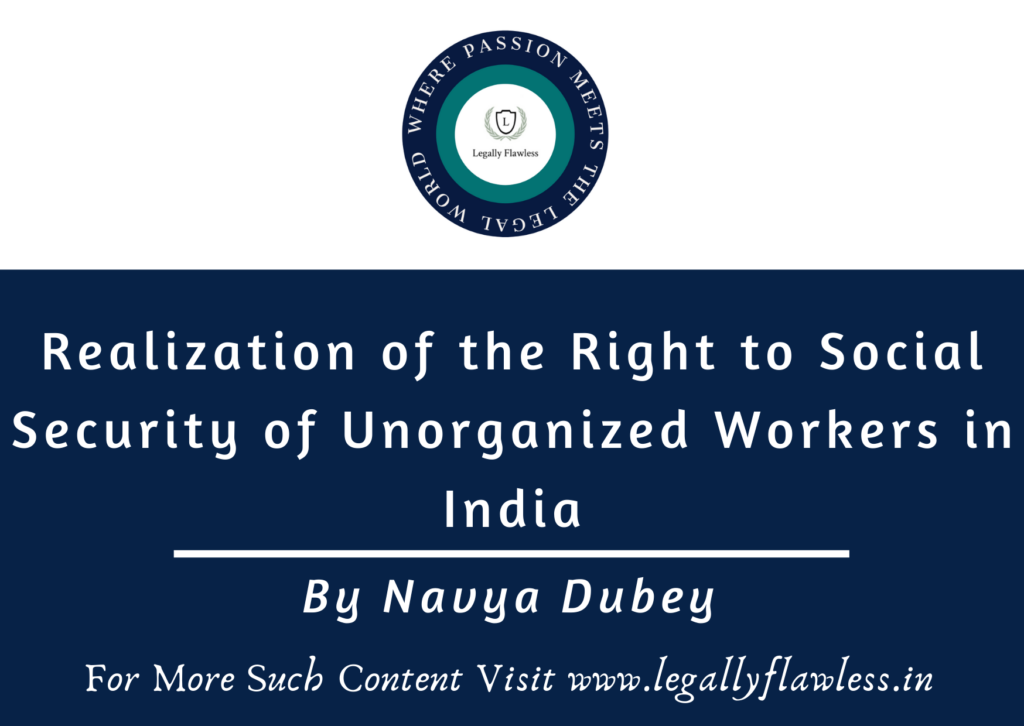
Table of Contents
Introduction
In India, the social security of unorganized workers is governed by the Unorganised Workers’ Social Security Act, 2008. This act aims to provide social security benefits to workers in the unorganized sector, such as construction workers, street vendors, domestic workers, and agricultural laborers, among others.The act mandates the creation of a National Social Security Board and State Social Security Boards to implement social security schemes for unorganized workers. The board identifies and registers unorganized workers and facilitates their access to social security schemes.
Some of the social security schemes available for unorganized workers under this act include:
- Rashtriya Swasthya Bima Yojana (RSBY) – A health insurance scheme that provides cashless treatment for unorganized workers and their families.
- Aam Aadmi Bima Yojana (AABY) – A life insurance scheme that provides insurance coverage to unorganized workers and their families.
- National Pension Scheme for Unorganized Workers (NPS-UW) – A pension scheme that provides regular income to unorganized workers after they reach the age of 60.
- Handloom Weavers’ Comprehensive Welfare Scheme – A scheme that provides financial assistance and benefits to handloom weavers and their families.
- Building and Other Construction Workers’ Welfare Scheme – A scheme that provides social security benefits to construction workers, such as healthcare, education, and housing assistance.
State Patenalism: Vis a vis Unorganised Workers
State paternalism refers to the approach where the state assumes the role of a parent and makes decisions on behalf of its citizens. In the context of social security for unorganized workers, state paternalism could manifest itself in policies and programs that are designed to provide social protection to this vulnerable group. However, this approach has been criticized as it may restrict the agency and autonomy of individuals.
Here are some examples of state paternalism in social security for unorganized workers:
- Mandatory enrollment: The government may require unorganized workers to enroll in social security schemes, whether or not they want to participate. This approach limits the choice of workers and may not take into account their unique needs and circumstances.
- Limited options: The government may limit the range of social security schemes available to unorganized workers, thereby reducing their options and agency in selecting a plan that best suits their needs.
- Benefit restrictions: The government may impose restrictions on the benefits that unorganized workers can receive, such as limiting the amount of maternity leave or retirement benefits. This approach may not reflect the diverse needs and aspirations of workers.
- Paternalistic messaging: The government may use paternalistic messaging to promote social security schemes for unorganized workers. For example, they may use slogans that appeal to emotions rather than providing information that helps workers make informed decisions.
While state paternalism can be seen as a way to provide social protection for unorganized workers, it is important to recognize the potential limitations and drawbacks of this approach. Policymakers should strive to strike a balance between providing social protection for vulnerable groups and respecting the agency and autonomy of individuals. A participatory approach that involves unorganized workers in the design and implementation of social security programs can help to promote autonomy and ensure that the needs and preferences of workers are taken into account.
Artificial Intelligence and Online Dispute Resolution
Workers as Citizens
The realization of the right to social security for unorganized workers requires a multifaceted approach that involves various stakeholders, including the government, employers, workers’ organizations, civil society groups, and international organizations. Here are some key steps that can be taken to realize the right to social security for unorganized workers:
- Legal recognition: The government should recognize the right to social security for all workers, including those in the unorganized sector. Laws and policies should be developed to ensure that unorganized workers have access to social security benefits.
- Outreach and awareness-raising: Efforts should be made to raise awareness among unorganized workers about their right to social security benefits. Outreach campaigns, educational programs, and workshops can help to inform workers about their entitlements and how to access them.
- Registration: Unorganized workers should be registered with relevant authorities to enable them to access social security benefits. This could involve the development of registration mechanisms that are accessible and affordable for unorganized workers.
- Social protection floor: A social protection floor should be established to provide a basic level of social security for all workers, including those in the unorganized sector. This could include benefits such as health care, maternity benefits, and old age pensions.
- Universal schemes: The government should develop universal social security schemes that cover all workers, regardless of their employment status. These schemes could be funded through a combination of contributions from workers, employers, and the government.
- Partnership with employers: Employers in the unorganized sector should be encouraged to contribute to social security schemes for their workers. This could be facilitated through incentives, such as tax breaks or subsidies.
- Monitoring and evaluation: The implementation of social security schemes for unorganized workers should be monitored and evaluated to ensure that they are effective and reaching their intended beneficiaries. This could involve regular surveys and assessments to measure the impact of social security schemes on the well-being of unorganized workers.
Overall, realizing the right to social security for unorganized workers requires a concerted effort from all stakeholders, as well as a long-term commitment to addressing the challenges and barriers that prevent access to social security benefits.
Parameters for evaluating Social Security Coverage:
The evaluation of social security coverage for unorganized workers typically involves the assessment of several key parameters, including:
- Coverage: This refers to the extent to which unorganized workers have access to social security benefits. The evaluation should take into account the type of benefits available, the eligibility criteria, and the percentage of the target population that is covered.
- Adequacy: This parameter considers the level of social security benefits provided to unorganized workers. The adequacy of benefits should be assessed in relation to the needs of the target population and the cost of living in the relevant geographical area.
- Accessibility: This parameter evaluates the ease with which unorganized workers can access social security benefits. This includes assessing the availability and accessibility of social security institutions and the processes involved in claiming benefits.
- Affordability: This parameter refers to the cost of accessing social security benefits for unorganized workers. The evaluation should assess the cost of premiums or contributions, as well as any out-of-pocket expenses, such as co-payments or deductibles.
- Sustainability: This parameter considers the long-term viability of the social security system for unorganized workers. The evaluation should assess the financial sustainability of the system, as well as its capacity to adapt to changing social and economic conditions.
- Effectiveness: This parameter measures the impact of social security coverage on the well-being of unorganized workers. The evaluation should assess the extent to which social security benefits are reducing poverty and improving health outcomes, as well as their impact on labor market participation and productivity.
Judicial Precedents
In the case of Rural Litigation and Entitlement Kendra, Dehradun v. Uttar Pradesh, the court stated that according to the Indian Constitution’s Article 21, the right to life also encompasses the right to a means of subsistence, according to the court.
Furthermore, in Union of India v. People Union for Democratic Rights, the court determined that being a beggar violates the fundamental human rights to live in dignity and respect as well as being a form of forced labour. A violation of Article 23 of the Indian Constitution occurs when someone uses workers without paying the required minimum wage.
Worker’s right to work in a safe and healthy environment
Conclusion
Despite the availability of these schemes, the implementation and reach of social security benefits to unorganized workers remain a challenge in India. Many unorganized workers are unaware of their entitlements, and there is a need for more effective implementation and outreach efforts to ensure that these workers receive the social security benefits they deserve.
Overall, the evaluation of social security coverage for unorganized workers requires a comprehensive assessment of multiple parameters, as well as an understanding of the specific needs and challenges faced by this population.
This article is authored by Navya Dubey, third year student pursuing BA. LL.B (Hons.) from Institute of law, Nirma University.
All efforts are made to ensure the accuracy and correctness of the information published at Legally Flawless. However, Legally Flawless shall not be responsible for any errors caused due to oversight or otherwise. The users are advised to check the information themselves.


